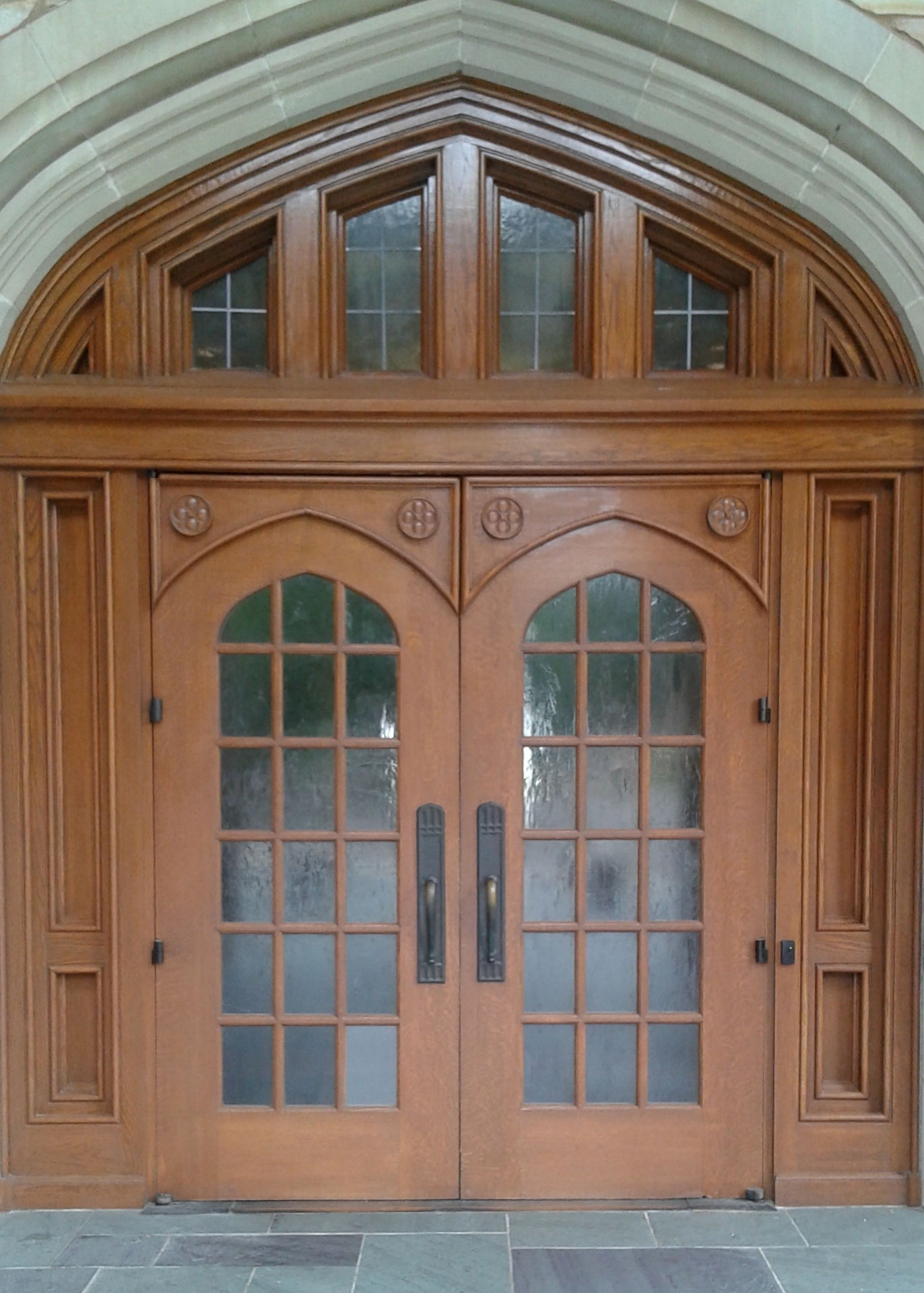
LIS 648
Reflective Journal
Week 1 May 31- June 3
Overview
This summer shall prove to be quite an exciting endeavor. For the next twenty-five days, I shall be observing, processing and learning at one of the top academic institutions of the mid-south, Rhodes College. Rhodes College, initially known as the Masonic University of Tennessee was founded in 1848 in Clarksville, Tn. After relocating to Memphis, Tennessee and changing the name to Southwestern, the school rededicated its name after the former president Peyton Nalle Rhodes. Thus since 1984 students from around the world have been coming to receive the finest education at Rhodes College.
If you ever visit Rhodes College, you will be stepping into another world. Located in the heart of Memphis, the grounds offer visitors an Oxford-like picturesque experience. I was mesmerized by the beautiful structure which was to be my internship. Let me share my first week's experience.
Tasks
• Familiarize with Rhodes Special Collection processing.
• Overview of the Richard Halliburton Collection.
• Read about the life and works of Richard Halliburton.
• Learn the protocol for receiving new gift donations to the archives.
• Disassemble the Rhodes College 1610 exhibit.


Experiences:
• Take a tour of the Paul Barrett Library.
• Observed a rare Roman Coin Collection housed in the archives.
• Visited with the curator of the University of Memphis Archives.
• Watched the Archon computer software used by the staff for identifying and recording archival material.


The Year 1616, Roman Coins &
The Great Adventurer Richard Halliburton
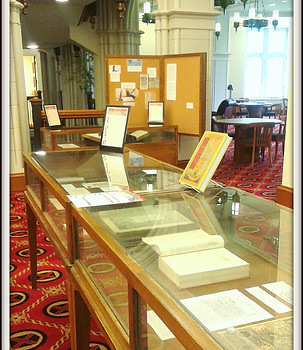

LIS 648
Reflective Journal
Week 1 May 31- June 3
Overview
This summer shall prove to be quite an exciting endeavor. For the next twenty-five days, I shall be observing and learning at one of the top academic institutions of the mid-south, Rhodes College. Rhodes College, initially known as the Masonic University of Tennessee was founded in 1848 in Clarksville, Tn. After relocating to Memphis, Tennessee and changing the name to Southwestern, the school rededicated its name after the former president Peyton Nalle Rhodes. Thus students from around the world have been coming to Rhodes receiving the finest education for over ninety years.
If you ever visit Rhodes College, you will be stepping into another world. Located in the heart of Memphis, the grounds offer visitors an Oxford-like picturesque experience. I was mesmerized by the beautiful structure which was to be the location of my internship. Let me share my first week's experience.
Tasks
• Introduced to the Rhodes Special Collection processing procedures.
• Gained an overview of the Richard Halliburton Collection.
• Read about the life and works of Richard Halliburton.
• Learned the protocol for receiving new gift donations to the archives.
• Assisted in disassembling the 1616 exhibit.
Experiences:
• Took a tour of the new Paul Barrett Library.
• Observed a rare Roman Coin Collection being processed.
• Visited with the curator of the University of Memphis Archives.
• Watched the Archon computer software used by the staff for identifying and recording archival material.

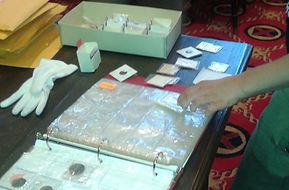


Reflections
I. Known through coursework:
This week many terms and tools learned from LIS 647 appeared throughout the week. From the last semester's exercise, I was aware of many concepts. Terms such as accessioning, provenance and arrangements were practiced in the day’s activities.
II. New Information:
Associate Curator Bill Short, my supervisory instructor, will be guiding me throughout the summer. Mr. Bill Short is very diligent in exposing me to the professional language and preservation techniques. What was exceedingly important was the historical background information he provided so that I may gain a deeper understanding of the materials we will be working with. This week we covered the historical relavance to the year 1616, the practical use and methods of early Roman coin production and the rare acquisition of well-known author Shelby Foote.
The most intriguing discussion revolved around the main project for my practicum the Richard Halliburton Collection.
To be frank, I was not as familiar with Halliburton as I should have been. Yet after hearing Halliburton’s exciting tale, plus reading a book loaned to me entitled The Forgotten Adventures of Richard Halliburton: A High-Flying Life from Memphis to Timbuktu by R. Scott Williams, I was keen to delve into handling this precious assembly. Throughout the summer, I will share more about this exciting explorer, and I hope his body of work hope will entice others to know more about him as well.
Next Week's Review Soon
LIS 648
Reflective Journal
Week 2 June 6- June 9, 2016
Overview
Last week my practicum supervisor Bill Short exposed me to an overflowing reservoir of repositories entrusted to Rhodes College. As I became familiar with the campus and faculty, the more excited I became knowing I would gain a wealth of experience at this institution. This week my task was archival arrangement and describing Richard Halliburton items. As with any body of work, organization and clarity of processing must be decided before one can begin. There are three separate collections of the Richard Halliburton Archives. The section I shall have to arrange will be named the General Collection. This collection comprises of donations from various donors who felt Rhodes College would best benefit from having these documents. Many of these materials are donated from many people who admired and was greatly inspired by Richard and his works. Questions arose on best description practices. Next week the goal shall be to develop a blueprint that can be used for the next person to follow.

Tasks:
-
Sorting through Richard Halliburton original papers.
-
Separating material ascribed to the General Collection or the other collections.
-
Researching items that did not have adequate information for description.
-
Starting a blueprint or outline on how to proceed with the arrangement.
Arrangement Begins
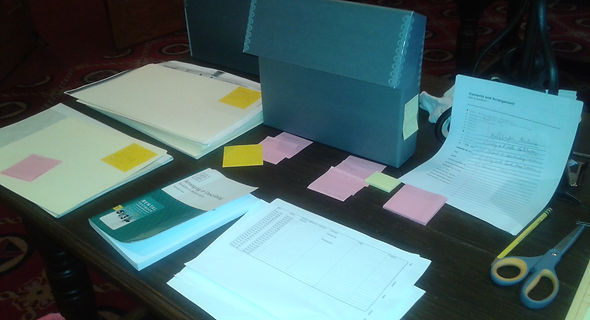
I. Known through coursework:
-
From course LIS 647 Introduction to Archival Organization I was able to apply these concepts to the Richard Halliburton Archives arrangement process.
-
accession
-
accessioning
-
provenance
-
respect de fonds
-

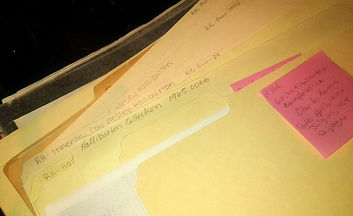
II. New Information
-
Toured the campus and learned the history behind many of the historic structures.
-
Compared and contrasted processing procedures between our public library arrangement policies and Rhodes archival policies.
-
Learning about the various types of preservation techniques and materials used for items such as:
-
Magazines circa 1930’s
-
Newspapers circa 1930’s
-
Photograph copies vs. original
We have just scratched the surface but made progress. Next week will be an update on our description outline. Please for more information on Richard Halliburton https://dlynx.rhodes.edu/jspui/handle/10267/11727
Touring, Tools and Tasks
LIS 648
Reflective Journal
Week 3 June 13- June 17, 2016
Overview
Overview
Last week I mentioned that many papers and manuscripts shall be placed in the Richard Halliburton Archive’s General Collection. In making progress, the go-ahead for a temporary spreadsheet was approved. Sorting multiple items from multiple sources can be complicated but with a good plan in place, the arrangement of most any collection can be achievable. This is what I am finding with the Richard Halliburton Archives. The first set of boxes contains newspaper clippings, magazines, and other publications with references to Halliburton. Then I was introduced to personal letters handwritten by Richard Halliburton’s father, Wesley Halliburton. This is important because transcribing cursive writing may be a skill needed to describe materials for a collection. Fortunately, most of the letters that were in the folder have already been transcribed by another archive student. Later in the program, there will be other boxes that must be processed such as photographs, brochures, and other various items related to Richard Halliburton’s life and career.
Aside from the important task of sorting, I was treated to touring the famous Halliburton Tower, which was dedicated to the late Richard Halliburton by his father in 1962. Other notable attractions were viewing the President’s office, the old library and exploring the impressive features surrounding the buildings.
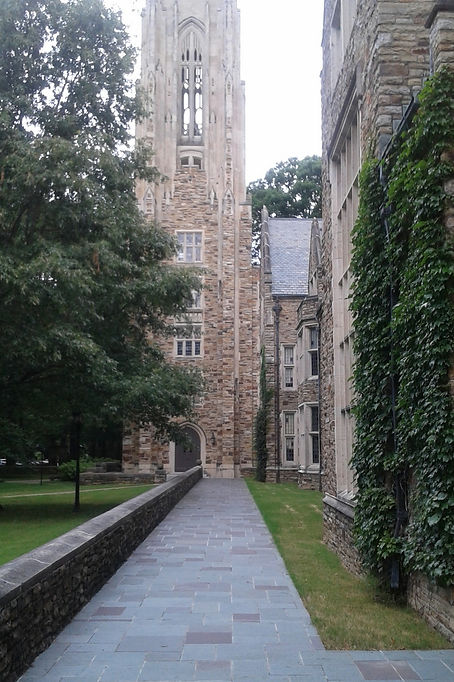
Tasks:
-
Continue sorting boxes for the Richard Halliburton Archives General Collection.
-
Assisted Mr. Short in 3 step cleaning process of 1852.
-
Used Cleaning pads in a circular motion very gently.
-
Used an archival brush to remove the dust.
-
Lined pages with archival paper before restoring the book in an archival box.



Reflections
-
Known through coursework:
-
Continued to apply concepts learned from Introduction to Archival Organization LIS 647 in drafting a spreadsheet for describing items within the collection.
Tasks:
-
Continue sorting boxes for the Richard Halliburton Archives General Collection.
-
I assisted Mr. Short in 3 step cleaning process of 1852.
-
Used Cleaning pads in a circular motion very gently.
-
Used an archival brush to remove the dust.
-
Lined pages with archival paper before restoring the book in an archival box.

Next week a writer interested in the Richard Halliburton story will visit the Library. Many of the records will be needed on hand for his research. Until then... happy archiving!
New Information:
1. Vermiculation
Full of worms.
Vermiculate. (n.d.). Retrieved June 21, 2016, from http://www.merriam-webster.com/dictionary/vermiculate
2. Lithography
A method of printing from a flat surface (such as a smooth stone or a metal plate) that has been prepared so that the ink will only stick to the design that will be printed
Lithography. (n.d.). Retrieved June 21, 2016, from http://www.merriam-webster.com/dictionary/lithography
3. Steel engravings
The art or process of engraving on steel
Steel engraving. (n.d.). Retrieved June 21, 2016, from http://www.merriam-webster.com/dictionary/steel engraving
every site.

A Writer Come to Rhodes
Reflective Journal
LIS 648
Week 4 June 20- June 23
Overview
This week I had the privilege of witnessing how a biographer utilized The Rhodes College Archival collections for his upcoming composition. Through the years, Richard Halliburton has continued to be a subject of inspiration and awe for many authors and this week again showed that Richard’s vitality beckons new admirers from various locations.
The last four weeks have given me a renewed appreciation for the archival profession. Providing access to information is the essential principles of every librarian and archival foundation. It is fulfilling to assist a researcher who wishes to examine rare and precious works. When one visits Rhodes College Archives, they will see the care that is provided towards the many materials entrusted to them.


Tasks:
-
Continued processing the Richard Halliburton Archives.
-
I have added descriptions which shall be later used for the Richard Halliburton Archives finding aid.
Experiences:
-
Viewed a rare short movie clip of Richard Halliburton along with the visiting author.
Reflections:
Known through coursework:
-
Maintaining care while handling fragile documents.
-
Ensuring original order for donated materials.
New Information:
-
Observed a standard archival practice of assisting researchers while maintaining a record of what is being used.
The Richard Halliburton Archives is extensive . I shall continue processing the Richard Halliburton Archives for the remainder of the program.
Until next week, happy archiving!
P.S.Please feel free to ask questions or make comments. I would love your feedback.
Progress!
LIS 648
Reflective Journal
Week 5 July 6-8
Overview
Progress
By now much of The Richard Halliburton Archival materials have been sorted and described. As each letter, photograph, news clipping, and other items are describes boxes are being filled and numbered for inventory. What may seem tedious to some is quite rewarding to an archivist. To an archivist, the sense of accomplishment comes in the ability to arrange and ensure records are accessible and retrievable. Once an ordering system has been put in place, any future donations will have a designated location to remain. Origination is the core goal of this project.

Tasks:
-
Described and process collection items.
-
Assigned numbers and descriptions to files and boxes.
-
Entered processed information into a database using Excel.

Experiences:
Short week but arranged over 3 boxes of records.
Reflections:
Known through coursework:
-
I continue to draw on lessons from Archival Organization LIS 647 to describe and organize files.
New Information:
-
Becoming acquainted with new types of mediums and documents.
-
Understanding the best practice to handle and preserve records.
Conclusion:
This was a short week due to the 4th of July holiday. Even with the enormous amount of documents to process, I see progress. I am confident that by the time my practicum is over a significant portion of the Richard Halliburton Archive Collection will see a happy conclusion.

Ernest Withers-
A Memphis Icon
LIS 648
Reflective Journal
Week 6 July 11- July 14
Week 6 July 11- July 14
Overview:
This week we visited the Dr. Earnest Withers archives with head Archivist Carol McCarley. Ernest Withers was Memphis, Tennessee’s most iconic photojournalist of black history for over 60 years. Some of the most profound and memorial images of the civil rights movement were captured by Withers. Because of his keen insight and tireless commitment to his craft, we are fortunate to have these exceptional images of black life, including the famous “I am a Man” photographs taken during the sanitation workers, strike that called for the assistance of Dr. Martin Luther King.
Today his works are entrusted to his daughter Rosalind Withers, who in turn is working with Carol McCarley and Rhodes College students to organize, preserve and document this vast collection. These dedicated archivists have made what may seem like impossibility one year ago to a possible realization toward completion today. There are still many negatives and photos that have to be processed yet with preservation and professionalism, Dr. Withers legacy will be available to inspire many generations to come.

Experiences:
-
Visited the Earnest Withers Photographic Archives\
Reflections:
Known through coursework:
-
Organization regarding quantity/extent. It is important for the archivist to know the extent of the Withers Collection due to the vast volume of material.
New Information:
-
There are multiple ways to represent a collection depending on the medium and the size. Due to the size and type of records, the first objective for the Earnest Withers Collection was to develop an inventory.
-
Link to know more about Earnest Withers and his works
http://www.bealestreet.com/ernest- withers-museuale.html

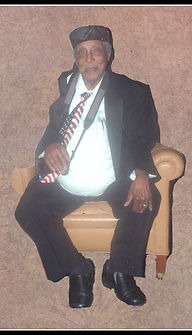
Conclusion:
An archivist has many challenges when it comes to procuring and arranging collections. You have to be prepared, patient and methodical to provide the best service to those who have entrusted you with their valuable items. This week I saw that type of care given to the Earnest Withers Collection and witnessed the care and concern from The Wither’s family. It is that devotion that inspires an archivist.
It Came to an End.
LIS 648
Reflective Journal
Week 7 July 19 – July 22, 2016
Overview
The practicum is complete. For the past 7 weeks under the supervision of Bill Short, I have learned the most fundamental practices in archiving. The campus of Rhodes College enhanced my learning experience with its beauty and resemblance to the architecture you would find at Princeton or Oxford in England. Here, I gained insight into proper methods for preservation, arrangement and describing. Even more valuable was observing the professional dedication bestowed by other students towards the records housed at Rhodes College. It was encouraging to witness teamwork, diligence and a willingness of others to share useful information. Over these past weeks, I became acquainted with an extraordinary adventurer Richard Halliburton. His life’s work came alive while I sorted through his collection of photographs, personal letters, and news clippings. As we processed his many holdings, I became to understand that his life influenced so many people and will continue to do so for years to come.



Here is a recap of my other experiences.
-
Was introduced to a Roman coin collection and watched how these rare items were protected and contained.
-
The use of proper tools to clean rare books.
-
Visited the University of Memphis academic archives.
-
Learned new archival terms such as lithography, vermiculation and steel engravings.
-
Visited the Earnest Withers Archives.


Reflections:
The courses at University of Southern Mississippi prepared me for this practicum. Now with new skills gained through instructions by Mr. Short, I am ready and excited to take on new assignments.
Side note: Because I enjoyed my work at Rhodes College, I shall be volunteering to see the completion of the Richard Halliburton Collection.
Mr.Milton the Library pup
saying goodbye!

The Great British Studies Class Of 2017


Welcome and Cheers!
June 1st was the beginning of what was to be a life changing experience for me and other fortunate students who took the plunge and traveled to London. Within this blog I shall attempt to immerse the reader on the wonders of British Culture. Glimpse at the libraries, artifacts, and outstanding architecture with me as we begin our journey.
Summer Alive Excursions
June 3, 2017
Students from various disciplines had the opportunity to join leading professors on unique tours within London. Some excursions included Harrods London Alive, British Museum London Alive, Sovereigns, Spies, and Suffragettes Alive Tours. I chose the Bloomsbury Alive Tour with Dr. Steedman as our guide.
"Take a tour of one of London's most famous neighborhoods, the center of its university district and some of the most beautiful squares in the city. We will walk through these beautiful urban gardens and visit locations where some of London's most famous writers - Charles Dickens and Virginia Woolf - once lived. We'll also pop into the British Museum for a quick look at the "Elgin Marbles," original pieces of the Parthenon that Greece very much wants to bring home (University Of Southern Mississippi, British Studies 2017)".

Side note: We came across the moving statue of Mahatma Gandhi, leader of The Indian Liberation movement.

T S Elliot once lived here.
Those small circles that you see are found throughout the city of London designating where prominent citizens once lived. Below was the home of John Maynard Keynes.

Along the River Thames
June 4th Welcome Reception
LET the Rhine be blue and bright
In its path of liquid light,
Where the red grapes fling a beam
Of glory on the stream;
Let the gorgeous beauty there
Mingle all that ’s rich and fair;
Yet to me it ne’er could be
Like that river great and free,
The Thames! the mighty Thames!
Poem by Eliza Cook
What better way to experience the sights of London than riding along the River Thames. The River Thames, an ancient river that powerfully winds its path through the center of London, is one of the city's primary sources for folklore, histories, and romanticized imaginations sparking intrigue and wonders in the minds of travelers.
The U of M British Studies Program treated students and faculty to a trip down the mighty river so many could get a glimpse of London's famous icons.
Music: Paddington- Bear Across the River
British Libraries and Information Centers
June 5-8
This week was packed full of wonders.
Unfortunately, for myself, I had to make an unexpected leave. But I would be remiss if I did not share an overview of the inspiring academic visits to Britain's esteemed centers of archives, literature, and manuscripts.

Victoria and Albert Museum/Blythe House
Founded in 1852 this museum is said to be the world's largest decorative arts and design collection.


British Library
Barbican Library
National Martime Museum


The National Maritime Museum is possibly one of the world’s largest maritime museums in the world. It houses maps, ship plans, textiles, naval uniforms and a host of artifacts pertaining to oceanic scholarship.
This Library is part of the Barbican Center an arts haven specializing in music, theater, film, and dance.
http://www.barbican.org.uk/visitor-information/barbican-library
The British Library contains extensive holdings ranging from over material dating back 3 thousand years. It is one of London’s premier libraries.
NOTE: It pained me not to visit these institutions. So much to see and learn yet it only inspires me to one day take a trip back to England and experience for myself the treasures which lay within.

British Studies Academic Week 2
Stratford England and Kings College
June 14-15

Statford England
Graveyard outside Holy Trinity.
Week 2 of our stay in England proved just as rewarding as the previous week. The British Studies LIS class took a day trip to Stratford England the home of William Shakespeare. This charming town with its period homes, inviting shops and lovely parks added to the flare of the journey. This was not a guided tour; however, we were free to explore the home of Shakespeare and even visited the site of his grave. See below
Holy Trinity Church
Site of William Shakespeare Tomb
Toward the end of the day, our class was treated to the Royal Shakespeare Company performance of Julies Caesar.
Our class was seated in a modern day rendition of the traditional Shakespearean theater; our Stratford experience was now complete.



Kings College Maughan Library




According to Kings College website, this institution was founded in 1829 by prominent politicians and churchmen as an alternative to the Church of England
(Kings College London, 2017). On the day we arrived our class was greeted by the Head of Special Collections Katie Sandbrook. She and a colleague gave us an exclusive preview of some of their rare and fascinating acquisitions such as books from the St. Thomas Historical Collection and The Guy's Historical Book Collection. Maughan Library can boast as having some of the rarest medical and travel books dating as far back as the 16th century. Below is an Early English book from the Foyle Special Collection.
Note: The black markings. Evidence of Censorship in Early England Library Collections.
Kings College Maughan Library is said to have over 20 thousand items that include Jazz, modern American music, and counterculture selections. Oh before I forget this is quite compelling. The library has an actual book autographed by one of America’s prominent citizens, Thomas Pain signed by him in 1743. Is that not amazing!
Published in 1661 ,this rare book depicts the people and geography of the Americas.
After the private showing the class was given a tour of the library and treated to tea in the Weston which contains part of a chapel built in 1617. Below are a few of the sculptures which adorn the hall.


For more on The Kings College Maughon Library Special Collections please visit https://www.kcl.ac.uk/library/archivespec/index.aspx




British Studies
Academic Week 3-Part I
June 19-21
Bletchley Park , Pitts Museum,

Bletchley Park
Intrigue, espionage, covert operations are the stuff good movies are made of as in the feature film The Imitation Game. Starring Benedict Cumberbatch, A film based on the brilliant cryptanalyst Alan Turing and many others who were instrumental in decoding German code messaging during WWII. Their work was said to be vital to engaging the enemy in battles. Kept in the 1940's period setting, Bletchley Park visitors can visit the code breaking huts, see the real machines, and explore the museum and the Mansion see on the right.
The Mansion
Pitt River Museum
Dinosaur Bones, shrunken heads, tribal magic artifacts, medieval weapons and so much more can be found at the Pits River Museum. This museum has three floors of ethnic and archaeological objects from all over the World. These images are some of the items you will find at the museum.

This sckull was used to enforce control over the enemy.
The headdress above is said to represent a crocodile which is sacred in The Cross River region of Tibet. The Crocodile was supposed to detect and protect against witches.

British Studies
Academic Week 3-Part II
June 19-21
Middle Temple Law Library and Christ Church University Library
The Week continued our academic visits to two highly esteemed institutions of higher learning. Our LIS class were given private tours of both libraries and their surroundings. Elizabeth Alderson, Administrative librarian lead us through the historic halls of Middle Temple Law Library discussing its rich historical heritage. Dating back to the the 14th century, Middle temple is one of four Inns that educate students for the Bar.
http://www.middletemple.org.uk/library-and-archive
Middle Temple Law Library
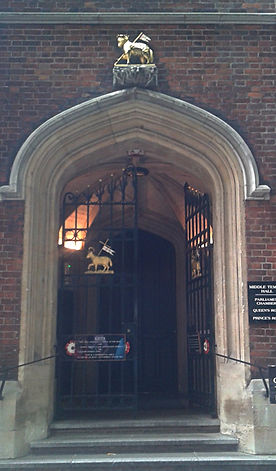

Inside Middle Temple Hall
This hall built around 1562 is the site of dinners, performances and speeches.
These plaques commemorate the barristers and judges who have hosted elaborate banquets for its members.
http://www.middletemple.org.uk/about-us/history/middle-temple-hall


Below are dormitories located across from the library. How grand.
Christ Church Library


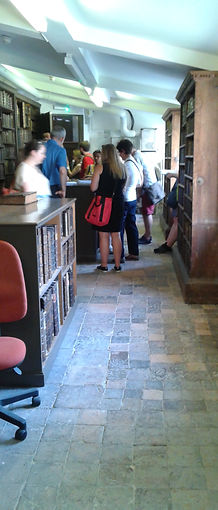



There is a place, like no place on earth. A land full of wonder, mystery, and danger. Some say, to survive it, you need to be as mad as a hatter. Which, luckily, I am.”
― Lewis Carroll
Walking in the footsteps of Lewis Carroll, author of Alice and Wonderland. Christ Church Library is where one can appreciate the world which inspired this timeless work of literature.
Christ Church University is located in Oxford England whose roots go back to Henry the VIII who was instrumental in founding the school in 1546.
TThis room is not open to the public. It houses rare books dating back to the 15th century. Also, notice the tile flooring. That tile was made during the medieval period and had not been altered in any way.
These photographs can only give a glimpse of the beauty of this library. Above the library is the majesty of the British architecture. Although we were not permitted to take photos of the actual artifacts our class was treated to view unique items such as Queen Elizabeth I personal prayer book.
Excursions, Ventures, Day Trips and Weekend Travel
The British Studies Program allotted plenty of free time for students to venture and conduct independent excursions or participate in some of the trips planned by the department. Trips were taken to Dover Castle, Canterbury, Stonehenge, Brighton and Edinburgh Scotland. To your left are photos from Brighton a lovely seaside town so captivating with its colorful homes, delicious eateries and unique shops.
Brighton
Typical Brigton Neighborhood

Fish and Chips Restaurant

Royal Pavilion
Exoctic and lavish palace of King George IV.
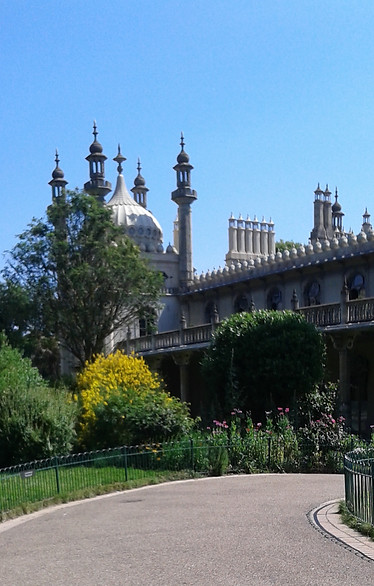
Typical shops which line the streets of Brighton.

British Studies Academic Week 4
June 27-28
Royal Geographical Society Library and Archive and St. Paul's Cathedral Library
The last week of the British Studies Program the LIS class visited THe Royal Geographical Society Library and St. Paul's Cathedral Library.
.
Royal Geographical Society Library and Archive
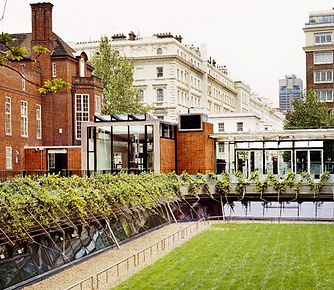
The Royal Geographical Library is known of course collections about geography. What that entails is maps, globes, books from around the world. The site asserts that they contain two million items dating back 500 Years. Quite a repository for all things global.
royal-geographical-society-e74fab583c29d0500cc66c6ee40f620a Photo source: visitlondon.com
St. Paul’s Cathedral is the finest building that ever I did see;
There’s nothing can surpass it in the city of Dundee,
Because it’s most magnificent to behold
With its beautiful dome and spire glittering like gold.
And as for Nelson’s Monument that stands in Trafalgar Square,
It is a most stately monument I most solemnly declare,
And towering defiantly very high,
Which arrests strangers’ attention while passing by.
William McGonagall
St. Paul's Cathedral Library

The last site scheduled for the LIS students was a trip the beautiful St. Paul's Cathedral. An astonishing 1400 year history is what visitors can hope to find at this library. The church was around before the great fire of London in 1612. Although most of the church was destroyed, there still remain monuments from that period housed at the Church.
(ca. 1890) [St. Paul's Cathedral, West Front, London, England]. England London, ca. 1890. [Between and Ca. 1900] [Photograph] Retrieved from the Library of Congress, https://www.loc.gov/item/2002696932/.nd edit me. It's easy.

Farewell London
To the City of London
London, thou art of town{.e}s A per se.
Soveraign of cities, semeliest in sight,
Of high renoun, riches, and royaltie;
Of lordis, barons, and many goodly knyght;
Of most delectable lusty ladies bright;
Of famous prelatis in habitis clericall;
Of merchauntis full of substaunce and myght:
London, thou art the flour of Cities all.
William Dunbar
The University of Southern Mississippi rewarded LIS British Studies students with a rewarding and exceptional educational experience. The month long stay has peeked this particular student with the goal to return and perhaps continue further research writing the illustrious responsories that you see on this blog until the next time may I leave you with a poem By William Dunbar


